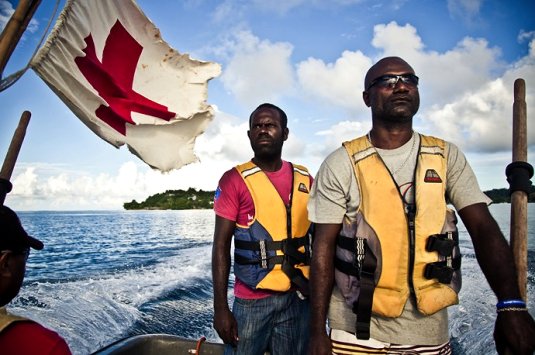
Looking to the past to turn back the tide in the Solomon Islands

13 August 2013
(IFRC photographer Benoit Matsha-Carpentier and writer Patrick Fuller went on mission in the Pacific to capture the effects of climate change on some of the most vulnerable places on earth, and to see what Red Cross Red Crescent National Societies are doing to assist people. Local voices, stories and pictures are all presented on Behind the Postcard, a special multimedia IFRC website. The story below is the second in a series.)
Forty-eight-year-old Silas Kere might be considered an expert on climate change: he has dedicated his life to finding solutions that help his community to adapt to the creeping effects of changing weather patterns on agricultural production in his village Ghatere, on Kolombangra Island in the remote Western Province of the Solomon Islands.
Reaching Kolombangra requires an hour’s boat journey from the nearest town of Gizo.
The village’s 1,000 inhabitants are largely cut off from the outside world. There are no roads, no cars and no TV.
Most families depend on processing copra (dried coconut) and subsistence farming – growing staple root crops like yam, cassava and taro.
“We used to know what crops to plant and when, but now it rains when it’s meant to be dry and the rains have got much heavier,” Silas says. “The seasons are mixed up and unpredictable. It’s also much hotter.”
The fluctuations in extreme rainfall and intense heat have caused many problems for local farmers. Yields are down and crops are prone to fungal infections and blight caused by attacks from pests.
Yields of staples that once thrived, such as sweet potato and cassava, have plummeted.
Shallow water table
Pepilyn used to harvest 20 kilos of sweet potatoes from just three mounds of the tubers. Now she has to dig up ten mounds to find just five kilos. “We used to travel to Gizo to sell our vegetables,” she says.
“This was our livelihood but now we don’t have enough to sell. Our yields have dropped by at least 50 per cent in the past 20 years – now we have to work harder and plant much more than before.”
Silas Kere has been working with Pepilyn and other members of the village, experimenting with different agricultural techniques, using trial and error to find new ways of growing food and to see which plants thrive under the changing weather conditions.
The village is dotted with disused wooden canoes suspended from the ground that are filled with an array of healthy-looking vegetables sprouting from manure.
The shallow water table was causing water-logging of household vegetable patches, so Silas struck upon the idea of raised vegetable beds or basket gardens to overcome the problem.
The direct effects of climate change in Ghatere are being exacerbated by the threat from natural disasters.
Since 2009, Ogier Kiko, who manages the Solomon Islands Red Cross office in Gizo, has been running a climate change adaptation and disaster risk reduction programme supported by the European Commission’s Directorate-General for Humanitarian and Civil Protection (ECHO) and the French Red Cross.
The project is underway on four islands in the Western Province and Ghatere was one of the communities identified as having particular vulnerabilities.
“The impacts of climate change and threats posed by natural disasters are closely linked,” Ogier says. “Ghatere is prone to tsunamis, earthquakes and other natural hazards. The rise in sea level poses a very real threat to these coastal communities.”
‘King tides’
The first step for the Red Cross was to help the community establish a village disaster risk committee responsible for all disaster management programmes.
A vulnerability and capacity assessment was carried out to identify some of the main risks that needed to be addressed.
Having a village disaster response plan with an evacuation centre was top on the list followed by the construction of a seawall to protect the village from tidal surges.
The third priority was to establish HF radio communication in the local clinic to enable communication with Gizo hospital in the event of a major disaster.
In 2007, the village was inundated by a tsunami caused by an undersea earthquake 25 miles off the coast. Since then there has been a noticeable change in local tidal patterns.
During ‘king tides’ the sea surges into the low-lying village. In an effort to prevent this, the community built a seawall, but at barely a metre high it offers little defence against the sea.
Now, the Red Cross may give a helping hand to make the defences higher and stronger.
Inland lake
“We are looking at intervening on a number of different levels,” says Ogier. “We have already provided the village with some disaster preparedness stocks such as tarpaulins for emergency shelter and plastic jerry cans for storing water.
“We may also help with the construction of a raised evacuation centre and improve sanitation in the village by constructing toilets.”
Thirty-eight-year-old Puia Mosely makes a living from producing copra – dried coconut – which is sold for export. He is concerned about the impact that rising sea levels are having on the future of the coconut palms that fringe the lagoon behind the village.
“The tides are now much higher. As kids we used to play soccer where the lagoon is now”, he says, pointing to the vast inland lake leading out to the sea. “Now the sea is killing off our coconuts and sago palms and the salt water is coming into our gardens.”
Areas that used to be cultivated as vegetable gardens close to the edge of the sea now lie waterlogged and abandoned.
Villagers have had to relocate their gardens deep in the interior of the jungle where they face other problems such as raids on their plots from wild pigs and birds.
Solomon Islands Red Cross volunteers visit isolated populations by boat to provide assistance and preposition disaster management kits.
(Photo: Benoit Matsha-Carpentier/IFRC)
(Photo: Benoit Matsha-Carpentier/IFRC)